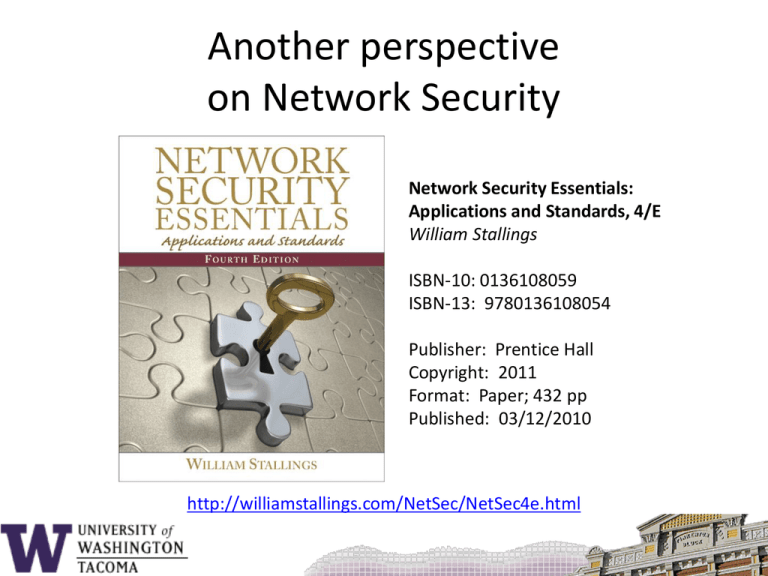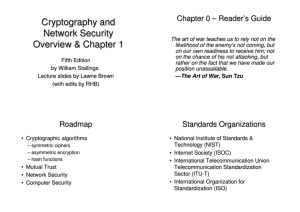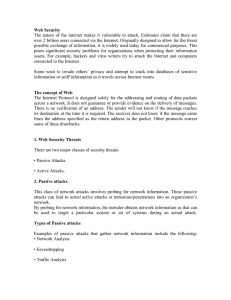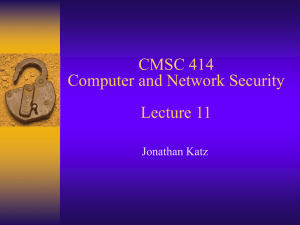Introduction to Network Security
advertisement

Another perspective on Network Security Network Security Essentials: Applications and Standards, 4/E William Stallings ISBN-10: 0136108059 ISBN-13: 9780136108054 Publisher: Prentice Hall Copyright: 2011 Format: Paper; 432 pp Published: 03/12/2010 http://williamstallings.com/NetSec/NetSec4e.html The Security Requirements Triad Computer Security The protection afforded to an automated information system in order to attain the applicable objectives of preserving the integrity, availability and confidentiality of information system resources (includes hardware, software, firmware, information/data, and telecommunications) http://csrc.nist.gov/publications/fips/fips199/F IPS-PUB-199-final.pdf Security Requirements • Confidentiality – Preserving authorized restrictions on information access and disclosure, including means for protecting personal privacy and proprietary information. • Integrity – Guarding against information modifications or destruction, including ensuring information nonrepudiation and authenticity. • Availability – Ensuring timely and reliable access to and use of information Security Attacks, Mechanisms & Services • Security Attack – Any action that compromises the security of information • Security Mechanism – A process / device that is designed to detect, prevent or recover from a security attack. • Security Service – A service intended to counter security attacks, typically by implementing one or more mechanisms. Threats & Attacks … but threat and attack used nearly interchangeably Security Threats / Attacks … … Security Threats / Attacks Passive Attacks Active Attacks (1) Active Attacks (2) Security Services (X.800) • Authentication – The assurance that the communicating entity is the one it claims to be • Access Control – The prevention of unauthorized use of a resource • who can have access to a resource, • under what conditions access can occur, • what those accessing the resource are allowed to do • Data Confidentiality – The protection of data from unauthorized disclosure • Data Integrity – The assurance that data received are exactly as sent by an authorized entity (i.e., contains no modification, insertion, deletion or replay). • Non-Repudiation – Provides protection against denial by one of the entities involved in a communication of having participated in all/part of the communication. Security Mechanisms (X.800) http://www.itu.int/rec/T-REC-X.800-199103-I/e Model for Network Security The Human Element “Humans are incapable of securely storing high-quality cryptographic keys, and they have unacceptable speed and accuracy when performing cryptographic operations. (They are also large, expensive to maintain, difficult to manage, and they pollute the environment. It is astonishing that these devices continue to be manufactured and deployed. But they are sufficiently pervasive that we must design our protocols around their limitations.)” -- C. Kaufman, R. Perlman, and M. Speciner. Network Security: Private Communication in a Public World, 2/E Kaufman, Perlman & Speciner Prentice Hall, 2003 Understanding Opponents Anatomy of an Attack Phase 1: Reconnaissance Phase 2: Scanning Phase 3: Gaining Access Phase 4: Maintaining Access Phase 5: Covering Tracks and Hiding Counter Hack Reloaded: A Step-by-Step Guide to Computer Attacks and Effective Defenses, 2/E Skoudis & Liston Prentice Hall, 2006 Network Security Jobs










